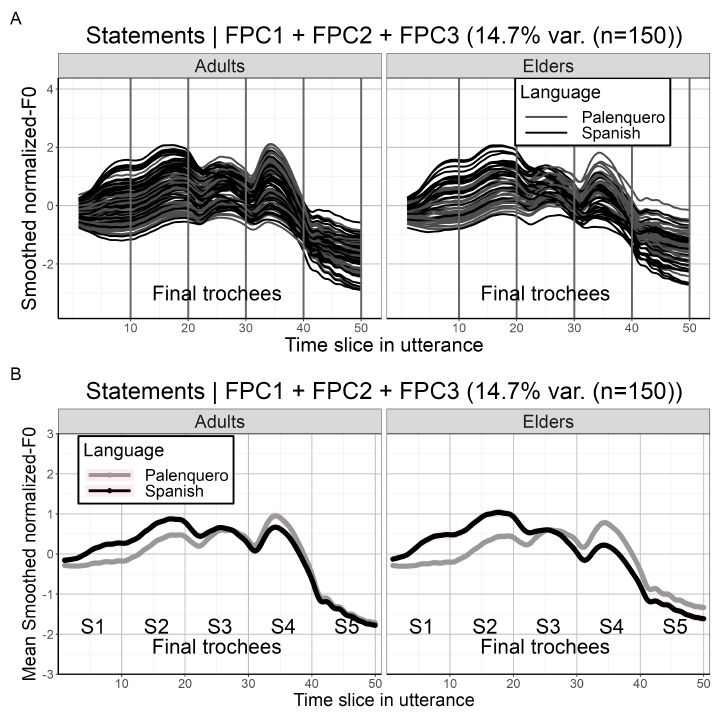Language-specific Prosody, Convergence, and Hyperarticulation in Statements of Palenquero/Spanish Bilinguals
 Image credit: ggplot2
Image credit: ggplot2
Abstract
This study explores the extent to which Palenquero/Spanish bilinguals, a community that appears to have a residual high tone of African origin, keep their two languages prosodically distinct across statements. It has been shown that bilinguals’ languages may be coactivated, showing cross-linguistic interactions such as transfer or interference. If such interactions are maintained over time, language-specific prosody could eventually converge. This phonological process is undoubtedly more accelerated when bilingual’s non-dominant language corresponds to the minority language in the community. Prosody is more susceptible to the adverse effects of majority languages than segmental information. Nevertheless, some creole languages that developed from the contact of African and European languages may exhibit hybrid prosodic systems with tones from substrate languages, and stress from the majority language. As prosodic convergence seems to be inescapable under these circumstances, which factors are supporting language-specific prosody in these populations? Palenquero is a creole language, and its most salient prosody was described as a type of phrase-final “cadence” (Friedemann & Patiño-Roselli, 1983), correlated with a falling pitch and a lengthening effect, stretched from the penultimate syllable until the end of the statement (Hualde & Schwegler, 2008). Correa (2017) suggested that although Palenquero/Spanish bilinguals produce more penultimate lengthening in Palenquero than Spanish, the prosody of the two languages did not hide great differences. The speakers use the same inventory of pitch accents and nuclear configurations in the two languages. However, Lipski (2016) noticed that, when these bilinguals listened to Palenquero intonation in Spanish utterances, they biased language identification in the direction of Palenquero (p.53). To better understand language-specific prosody and convergence in Palenquero/Spanish bilinguals, this study aims to answer whether the speakers use phrase-final lengthening language-specifically, and if they maintain the two languages intonationally distinct across statements. 234 five-syllable statements were elicited through a discourse completion task, with the participation of ten Palenquero/Spanish bilinguals, in two unilingual sessions. Phrase-final lengthening was assessed with linear mixed-effects models predicting vowel length in final trochees and iambs, from both adult and elderly bilinguals. Language-specific intonation was explored through F0 contours which were dimensionally reduced using Functional Principal Component Analysis. Final stress, language, and generational effects were tested on each F0 dimension, using linear mixed-effects models. Results indicate that penultimate lengthening is more pronounced in Palenquero than Spanish across elderly bilinguals, while adults do not show this language-specific distinction, having a shorter lengthening. Both generations kept their two languages intonationally distinct using plateau-shaped contours in Palenquero, and initial rises followed by steeper declinations in Spanish (see Fig.1). However, the elderly show a wider distance between the two languages. While adults exhibit more convergence, there does seem to be an underlying process (perhaps a substrate effect) driving plateau-shaped intonation in Palenquero, regardless of generation. Nevertheless, Spanish intonation of elderly speakers was significantly different from adults, suggesting that the former not only hyperarticulate Spanish prosody—likely as a result of imperfect group learning—but also, and as a consequence, enhance language-specific prosody incidentally, with no apparent cross-linguistic interaction.